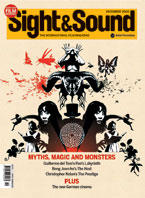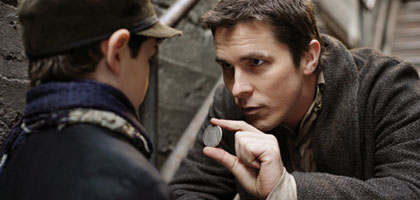Primary navigation

USA/UK 2006

Reviewed by Graham Fuller
Our synopses give away the plot in full, including surprise twists.
London, the 1890s. Alfred Borden and Robert Angier are apprentices and audience plants working for a magician whose illusions are designed by the ingénieur Cutter. When Angier's wife drowns on stage during a stunt, he blames Borden and resolves to avenge her death. Some years later, Borden and Angier are arch rivals on the magic circuit. Angier, aided by Cutter, is a flashy showman playing big halls. Borden is the better magician, but has little stage presence and performs at less glamorous venues. Borden marries Sarah, and has a daughter. Adopting disguises, the two men disrupt each other's shows. Borden finally becomes a star when he presents his Transported Man illusion, in which he disappears into one wardrobe after bouncing a ball across stage and re-emerges from another wardrobe to catch the same ball several yards away. Angier fixates on learning the secret behind the trick. He sends his assistant and girlfriend, Olivia, to steal Borden's coded notebook. She delivers the book to Angier, but becomes Borden's mistress. Sarah hangs herself. Angier travels to Colorado to learn what he can from the scientist Tesla. In London, Borden infiltrates the area beneath the stage during the climax of an Angier show. He finds Angier drowning, and is convicted of murder and sentenced to death. In prison, he learns that Angier is alive. Angier visits Borden and taunts him with the news that he is adopting Borden's daughter. Ignoring Cutter's advice, Angier prepares to mount a final show using an outsized cabinet made by Tesla. Borden's twin brother, with whom the magician performed the Transported Man illusion, is hung. Borden kills Angier's double, a clone birthed in Tesla's cabinet. Borden leaves with his daughter, secretly watched by Angier.
Harnessing the skills of the showman, the artisan and the scientist, illusionism was a midwife at the birth of film, but it has seldom made appealing cinematic subject matter.
The pact between audience and film-maker is based on the understanding that a movie is an illusory experience to begin with; making an audience conscious of its artifice through plot points is usually reductive. No sleight of hand or smoke-and-mirrors deception can compete with a sleight of camera (though Georges Méliès, for one, believed that the new medium could serve the old). The character of the illusionist is also problematic. Whether a grandstanding magician like the Orson Welles of F for Fake or a conman (the polished grifters played by Joe Mantegna and Steve Martin in David Mamet's House of Games and The Spanish Prisoner come to mind), the omniscient tour guide to other people's gullibility can seem gratingly smug.
The rival 19th-century London illusionists, Robert Angier and Alfred Borden, in Christopher Nolan's The Prestige offer a more inclusive form of ingenuity. Although the film's stunning reveals make the audience realise it has been duped, since that is also the experience of either Angier (Hugh Jackman) and Borden (Christian Bale) at every twist, there is a protagonist to empathise with each time. This not only makes for a more engaging kind of bafflement; it also prevents the audience from feeling that it is being spoken down to or outsmarted by a superior mind.
But Angier and Borden have more work to do than that. Respectively, a titled showman and a purist-artisan, their feud might have represented the class struggle in late Victorian London in much the same way as a magician's pursuit of a princess in Neil Burger's The Illusionist comments on the upheavals in fin-de-siècle Vienna. Instead, Nolan and his brother Jonathan's screenplay, which they adapted from Christopher Priest's novel, has a more ambitious subtext in mind.
In rationalising their consuming rivalry, Angier and Borden agree on the validity of their work as controlled entertainment that offers "the only way to escape all this", "this" being the daily grind rather than poverty per se. That Nolan has cinema in mind is emphasised at the outset by having Michael Caine's twinkly-eyed mechanic, Cutter, explain to Borden's daughter how a magic trick is founded on a three-act structure (pledge, turn, prestige); this implied reference to Aristotle's ancient blueprint for Hollywood movies will be lost on fewer filmgoers than it would have been before screenwriting became a Starbucks phenomenon. The Prestige's own screenplay, which wisely dispenses with Priest's contemporary wraparound plot, is skilfully dovetailed into three acts, their fragmented chronology more in keeping with Alejandro Gonzáles Iñárritu's narrative experiments than the backward logic of Nolan's 2000 film Memento.
This non-linearity underscores the identity crises that afflict Angier and Borden (the familiar plight of Nolan's protagonists) and all but drives them into each other's arms. Helplessly watched by Caine's ineffectual father figure, each man is doubled during the course of the story, and by the end the narcissistic Angier has multiplied himself: a fate predicted in the Magritte-like image of top hats scattered over a stretch of grass in the film's haunting first image. Both men (and/or their doppelgangers) become sexually involved with Angier's assistant Olivia (Scarlett Johansson); that they are physically linked by her, but forget about her when she is no longer useful, emphasises their more powerful mutual attraction. This is scarcely homoerotic, though Borden's jealous protection of his "secrets" at the cost of his wife's sanity hints at his closetedness and underscores the disposability of wives and mistresses. Lurching from saturnine cockney idealist to domestic tyrant, Bale is especially charismatic.
Following Insomnia (2002) and Batman Begins (2005), The Prestige is Nolan's third consecutive studio film. None has required or enabled him to work in the minimalist style of Following (1998) or in the jagged style of Memento. If he is evolving as a stylist, it is in small but telling increments, at least to these eyes. That aside, Wally Pfister's nervy, restless handheld camerawork suits the pleasingly muted Gothic scenes in which David Bowie's grim inventor, Tesla, and Andy Serkis' smirking Alley hint at a modern Frankenstein.